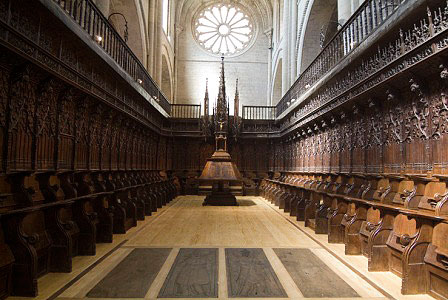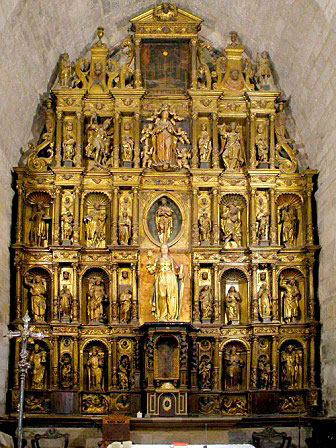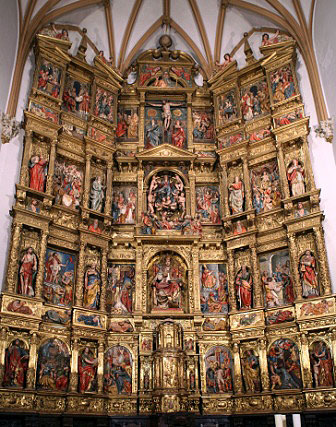30 August 2016
Tudela's workshops: architecture, visual arts and decorative arts
Sculpture workshops in Renaissance Tudela
Dr. Jesús Criado Mainar
University of Zaragoza
The 16th century was a time of consolidation for Tudela in the artistic field, both in architecture and in the plastic arts. The growth of the city and its main ecclesiastical institutions, as well as that of the numerous towns in the Ribera region, encouraged a sustained demand over time that favoured the installation of painters and sculptors, in some cases on an itinerant basis ( provisional ) and in others almost definitively, giving rise to a process with ups and downs that would reach its splendour in the centuries of the Baroque.
The particular interests of each artist, together with the specific circumstances they had to face, explain why each of them responded by organising their workshop in a particular way, thus giving rise to a rich and varied casuistry. The sculpture workshops opened in the city by Esteban de Obray and Domingo Segura are a good reflection of this changing reality, which must be complemented by the contribution of other sculptors who came to deal with specific commissions, such as Juan Martín de Salamanca, Ambrosio Bengoechea and Pedro González de San Pedro.
The arrival in Tudela of Esteban de Obray (doc. 1519-1551, †1551), a carver from Saint-Omer (Artois, Normandy), to work on the new choir stalls (1517/19-1525) of the collegiate church of Santa María was fundamental as he was the first professional sculptor to choose the capital of La Ribera as the site of his workshop, although over time the commissions led him to move his residency programtemporarily to other towns such as Calatayud (1525-1532), Pamplona (1539-1541) or Zaragoza (1542-1547). In this regard, it is worth noting that, although perhaps fortuitously, he ended up dying in Tudela in the spring of 1551.

Choral stalls in Tudela Cathedral
Esteban de Obray, 1517/1519-1522
(Photo: Antonio Ceruelo, courtesy of the Foundation for the Conservation of the Historical Heritage of Navarre)
issueThe itinerant nature of Esteban de Obray's activity prevented him from having a stable workshop with a large number of disciples and collaborators, in the manner of other great sculptors of his generation such as Damien Forment and Gabriel Joly. In fact, he chose to respond to each of the situations he had to deal with on an ad hoc basis: from the organisation of works of limited duration with numerous collaborators - as happened during the work on the choir stalls (1539-1541) at Pamplona cathedral, a large number of craftsmen have been documented at issue- to the punctual resourceto subcontracting - as he did in the main altarpiece (1529-1531) of the parish church of San Juan Bautista de Cintruénigo, whose carving work he handed over to his compatriot Guillemin Levêque because he was busy at that time on various commissions in Calatayud and the surrounding area; and as he undoubtedly did on numerous occasions to materialise the sculptural elements of his works. Finally, in exceptional undertakings such as that of the choir stalls (1542-1547) of the collegiate church of Santa María la Mayor y del Pilar in Saragossa, he had no problem in taking part in a collective commission divided between three workshops: his own and those of Juan de Moreto and Nicolás de Lobato.
BApart from the peculiarities described above, Esteban de Obray's activity was very important in the context of Renaissance sculpture in the middle Ebro valley and is unparalleled by that of the other artists who settled in the city from the middle years of the 16th century onwards.
In fact, the artistic stature of the following figure, Domingo Segura (d. 1544-1574), is much lesser. It is thought that this sculptor trained in the workshops of Sangüesa, whose consolidation took place in the central decades of the 16th century. The first data, from 1544 and 1545, however, place him in Zaragoza, in the circle of Juan de Moreto and Esteban de Obray, so he may well have been involved in the work on the aforementioned choir stalls of the Pilar. From there he moved on to Sangüesa, where he worked with Medardo de Picardía on the choir stalls (1552) of San Esteban de Sos del Católico before moving on to Tudela for the auction of the main altarpiece (1551-1556) of the parish church of La Magdalena.

High altarpiece of the parish church of Santa María Magdalena de Tudela
Domingo Segura, 1551-1556
Although the commission was awarded by auction to the wood turner Juan Remírez, the parish documentation reveals that, in reality, the altarpiece of the Magdalena was made by "Maese Domingo [Segura] and his brothers-in-law [the aforementioned Juan Remírez and the fusile maker Pedro Segura]". partnershipDomingo Segura headed a "family" businesswhich is in keeping with the workings of other Renaissance workshops in Sangüesa, where it was common for several members of the same family to work in painting - as in the case of the Sarasa family - and in sculpture - as was the case with the Labarzana and Berroeta families, among others. Although Domingo Segura remained in Tudela until 1568, it does not seem that this workshop modelcame to fruition at that time, beyond the fact that it anticipates the workings of the great Tudela altarpiece workshops of the 17th century.
The final decades of the 16th century, those of the developmentof Romanesque sculpture, coincided with a time of a certain recession for the Tudela sculpture workshops in which, despite everything, there was no lack of interesting names, especially Bernal Gabadi (doc. 1562-1600, †1601) -former partnerof Gaspar Becerra in the main altarpiece of Astorga cathedral, but whose production in Tudela has been almost entirely lost-, but also the assembler Juan de Ayuca. This meant that the major commissions of the time, among which the main altarpieces of the parishes of Valtierra and Cascante stand out, fell to artists from other creative centres.
written requestThe main altarpiece of the parish church of the Assumption of the Virgin of Valtierra (1577-1580 and 1590-1598) was first entrusted to the sculptor Juan Martín de Salamanca (doc. 1547-1580, †1580), who after a complex and eventful contracting process could only fill inthe sotabanco, the bench and the monumental tabernacle, as he died in the town of without being able to fill inthe commission. The documentation reveals that the Calatayud artist organised a large workshop on site, to which he sent many of his usual collaborators - including Miguel Pérez de Huérmeda, Jerónimo Urquizo Laguardia and Francisco Villalpando - and for which he also hired young sculptors such as Lázaro de Leiva and Lope García [de Tejada], who had worked for established masters such as the Riojan Juan Fernández de Vallejo. All this brings Juan de Salamanca's workshop in Valtierra closer to the workings of the great 16th-century workshops, as demanded by a projectof exceptional size and complexity, in which several more masters were to be involved from 1590 until its completion in 1598.

High altarpiece of the parish church of the Asunción de la Virgen de Valtierra
Juan Martín de Salamanca and others, 1577-1580 and 1590-1598
(Photo: Carlos Becerril)
The other major project is that of the main altarpiece (1590-1601) of the parish of the Assumption of Cascante, destroyed in an accidental fire in 1940. On this occasion, the local council called a competition in which the two disciples of Juan de Anchieta, Ambrosio Bengoechea (doc. 1581-1623, †1625) and Pedro González de San Pedro (doc. 1580-1608, †1608), together with Juan Ximénez de Alsasua, took part, and in which each master had to draw up a design for the altarpiece and make a sculpture. After discarding the third, the commissioners decided that an expert, the sculptor García de Arredondo from Burgos, should choose between the other two. But he opted for a Solomonic solution, ruling that both masters would share the work and that the design would combine elements of those presented by both: the central street of Bengoechea's design and the sides of the one contributed by Gonzalez de San Pedro.
The unfortunate decision of García de Arredondo -justified by the very high level of the two candidates- led to a process of realization full of problems in which Bengoechea and González de San Pedro reproached each other for all subject of faults or defects; in fact, they only agreement that the assembly should be entrusted to Domingo Bidarte. In spite of this, judging by the photographs that have reached us, the result was spectacular, demonstrating that the skill between great masters can lead to quality work .
